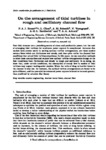On the arrangement of tidal turbines in rough and oscillatory channel flow
| dc.contributor.author | Bonar, Paul A.J. | |
| dc.contributor.author | Chen, L | |
| dc.contributor.author | Schnabl, AM | |
| dc.contributor.author | Venugopal, V | |
| dc.contributor.author | Borthwick, Alistair | |
| dc.contributor.author | Adcock, Thomas | |
| dc.date.accessioned | 2021-08-22T15:40:18Z | |
| dc.date.available | 2021-08-22T15:40:18Z | |
| dc.date.issued | 2019-04-25 | |
| dc.identifier.issn | 0022-1120 | |
| dc.identifier.issn | 1469-7645 | |
| dc.identifier.uri | http://hdl.handle.net/10026.1/17684 | |
| dc.description.abstract |
<jats:p>Fast tidal streams are a promising source of clean, predictable power, but the task of arranging tidal turbines for maximum power capture is complicated. Actuator disc models, such as the two-scale actuator disc theory, have proven useful in seeking optimal turbine arrangements, yet these models assume flows that are frictionless and steady, and thus quite unlike the channel flow conditions that actual tidal turbines experience. In this paper, we use numerical methods to relax these assumptions and explore how optimal turbine arrangements change as the flow transitions from frictionless and steady to rough and oscillatory. In so doing, we show that, under certain conditions, the assumption of quasi-steady flow in models of tidal turbines may neglect leading-order physics. When the ratio of drag to inertial forces in the unexploited channel is very low, for instance, the optimal turbine arrangements are found to be quite different, and the potential for enhanced power capture is found to be much greater than predicted by two-scale actuator disc theory.</jats:p> | |
| dc.format.extent | 790-810 | |
| dc.language | en | |
| dc.language.iso | en | |
| dc.publisher | Cambridge University Press (CUP) | |
| dc.title | On the arrangement of tidal turbines in rough and oscillatory channel flow | |
| dc.type | journal-article | |
| dc.type | Journal Article | |
| plymouth.volume | 865 | |
| plymouth.publication-status | Published | |
| plymouth.journal | Journal of Fluid Mechanics | |
| dc.identifier.doi | 10.1017/jfm.2019.68 | |
| plymouth.organisational-group | /Plymouth | |
| plymouth.organisational-group | /Plymouth/Faculty of Science and Engineering | |
| plymouth.organisational-group | /Plymouth/Faculty of Science and Engineering/School of Engineering, Computing and Mathematics | |
| plymouth.organisational-group | /Plymouth/Users by role | |
| plymouth.organisational-group | /Plymouth/Users by role/Academics | |
| dc.identifier.eissn | 1469-7645 | |
| dc.rights.embargoperiod | Not known | |
| rioxxterms.versionofrecord | 10.1017/jfm.2019.68 | |
| rioxxterms.licenseref.uri | http://www.rioxx.net/licenses/all-rights-reserved | |
| rioxxterms.type | Journal Article/Review |


